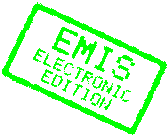Triple Multiplicities for sl(r + 1) and the Spectrum of the Exterior Algebra of the Adjoint Representation
A.D. Berenstein
and A.V. Zelevinsky
DOI: 10.1023/A:1022429213282
Abstract
A new combinatorial expression is given for the dimension of the space of invariants in the tensor product of three irreducible finite dimensional sl(r + 1)-modules (we call this dimension the triple multiplicity). This expression exhibits a lot of symmetries that are not clear from the classical expression given by the Littlewood-Richardson rule. In our approach the triple multiplicity is given as the number of integral points of the section of a certain  universal
universal  polyhedral convex cone by a plane determined by three highest weights. This allows us to study triple multiplicities using ideas from linear programming. As an application of this method, we prove a conjecture of B. Kostant that describes all irreducible constituents of the exterior algebra of the adjoint sl(r + 1)-module.
polyhedral convex cone by a plane determined by three highest weights. This allows us to study triple multiplicities using ideas from linear programming. As an application of this method, we prove a conjecture of B. Kostant that describes all irreducible constituents of the exterior algebra of the adjoint sl(r + 1)-module.
 universal
universal  polyhedral convex cone by a plane determined by three highest weights. This allows us to study triple multiplicities using ideas from linear programming. As an application of this method, we prove a conjecture of B. Kostant that describes all irreducible constituents of the exterior algebra of the adjoint sl(r + 1)-module.
polyhedral convex cone by a plane determined by three highest weights. This allows us to study triple multiplicities using ideas from linear programming. As an application of this method, we prove a conjecture of B. Kostant that describes all irreducible constituents of the exterior algebra of the adjoint sl(r + 1)-module.Pages: 7–22
Keywords: tensor product multiplicities; systems of linear inequalities
Full Text: PDF
References
1. A.D. Berenstein and A.V. Zelevinsky, "Involutions on Gelfand-Tsetlin patterns and multiplicities in skew gln-modules," Doklady AN SSSR, vol. 300, no. 6, pp. 1291-1294, 1988 (in Russian).
2. A.D. Berenstein and A.V. Zelevinsky, "Tensor product multiplicities and convex polytopes in partition space," Journal of Geometry and Physics, vol. 5, no. 3, pp. 453-472, 1988.
3. N. Bourbaki, Groupes et algebres de Lie, Ch. IV, V, VI. Hermann: Paris, 1968.
4. C. Carre, "Le decodage de la regie de Littlewood-Richardson dans les triangles de Berenstein- Zelevinsky," preprint, April 1991.
5. C. Davis, "Theory of positive linear dependence," American Journal of Mathematics, vol. 76, pp. 733-746, 1954.
6. D. Gale, The theory of linear economic models, McGraw-Hill, New York, 1960.
7. I.M. Gelfand and A.V. Zelevinsky, "Polytopes in the pattern space and canonical basis in irreducible representations of gl3," Functional Analysis and Applications, vol. 19, no. 2, pp. 72-75, 1985 (in Russian).
8. I.M. Gelfand and A.V. Zelevinsky, "Multiplicities and regular bases for gln," in Group theoretical methods in physics, Proc. of the third seminar, Yurmala, May 22-24,
1985. Nauka, Moscow, vol. 2, pp. 22-31, 1986 (in Russian).
9. I.M. Gelfand, A.V. Zelevinsky, and M.M. Kapranov, "Newton polytopes of the classical resultant and discriminant," Advances in Mathematics, vol. 84, no. 2, pp. 237-254, 1990.
10. I. Macdonald, Symmetric functions and Hall polynomials, Clarendon Press, Oxford, 1979.
11. E. Verlinde, "Fusion rule and modular transformation in 2d conformal field theory," Nuclear Physics B, vol. 300, pp. 360-376, 1988.
2. A.D. Berenstein and A.V. Zelevinsky, "Tensor product multiplicities and convex polytopes in partition space," Journal of Geometry and Physics, vol. 5, no. 3, pp. 453-472, 1988.
3. N. Bourbaki, Groupes et algebres de Lie, Ch. IV, V, VI. Hermann: Paris, 1968.
4. C. Carre, "Le decodage de la regie de Littlewood-Richardson dans les triangles de Berenstein- Zelevinsky," preprint, April 1991.
5. C. Davis, "Theory of positive linear dependence," American Journal of Mathematics, vol. 76, pp. 733-746, 1954.
6. D. Gale, The theory of linear economic models, McGraw-Hill, New York, 1960.
7. I.M. Gelfand and A.V. Zelevinsky, "Polytopes in the pattern space and canonical basis in irreducible representations of gl3," Functional Analysis and Applications, vol. 19, no. 2, pp. 72-75, 1985 (in Russian).
8. I.M. Gelfand and A.V. Zelevinsky, "Multiplicities and regular bases for gln," in Group theoretical methods in physics, Proc. of the third seminar, Yurmala, May 22-24,
1985. Nauka, Moscow, vol. 2, pp. 22-31, 1986 (in Russian).
9. I.M. Gelfand, A.V. Zelevinsky, and M.M. Kapranov, "Newton polytopes of the classical resultant and discriminant," Advances in Mathematics, vol. 84, no. 2, pp. 237-254, 1990.
10. I. Macdonald, Symmetric functions and Hall polynomials, Clarendon Press, Oxford, 1979.
11. E. Verlinde, "Fusion rule and modular transformation in 2d conformal field theory," Nuclear Physics B, vol. 300, pp. 360-376, 1988.
